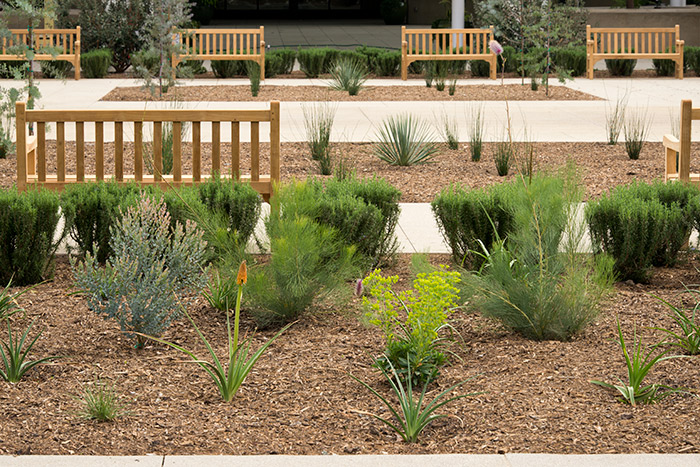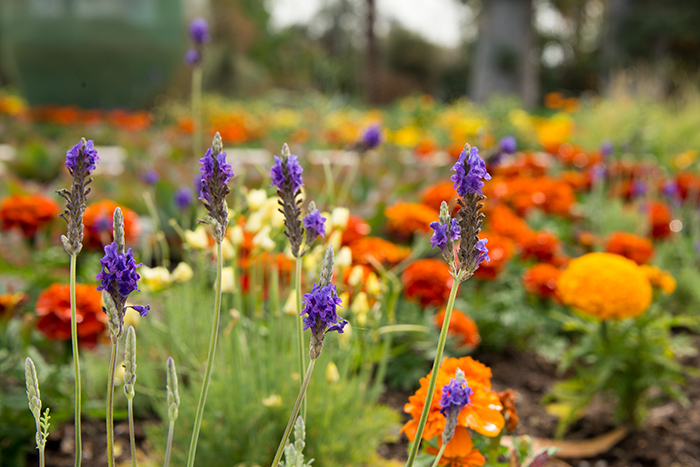The Huntington’s blog takes you behind the scenes for a scholarly view of the collections.
A California Garden
Posted on Fri., March 27, 2015 by

The San Gabriel Mountains form a backdrop to the Celebration Garden, with the new Mapel Orientation Gallery on the left and new café on the right.
When the Steven S. Koblik Education and Visitor Center opens on April 4, 2015, Scott Kleinrock hopes the first things visitors notice are the gardens.
As garden design and landscape construction coordinator, Kleinrock has created garden spaces that complement the new buildings, which include an orientation gallery, a state-of-the-art auditorium, an elegant café, and four new classrooms, among other structures. The gardens have even taken on some of the roles normally reserved for indoor areas.
“These new spaces do everything a garden should do: they’re beautiful, they provide shelter, they’re comfortable places to talk with people, and gorgeous things will happen in them throughout the year,” says Kleinrock. A main goal of the project was to use California natives and dry-climate plants.
Kleinrock relished the idea of showcasing the broad range of drought-tolerant plants that can thrive in Southern California—from native plants you might see hiking in the nearby San Gabriel mountains to unusual specimens from far-off areas that share a Mediterranean climate, such as parts of Australia, South Africa, and southern Europe.
Visitors now arrive from the parking lot under soft, dappled shade provided by more than a dozen large California pepper trees (Schinus molle) and then enter a courtyard seating area sheltered by four stately podocarpus trees (mature Podocarpus gracilior, relocated from elsewhere on the property). A long allée of fruitless olives (Olea europea ‘Wilsonii’) leads to the Education and Visitor Center’s formal entrance.
On either side of the allée are “hedge rooms” that enclose benches and tables, delineated by dwarf myrtle (Myrtus communis ‘Compacta’) that will eventually grow to be about three feet tall, lending the hedge rooms a sense of intimacy. Kleinrock hopes to see a cross-section of people congregate here—research scholars, school groups, families, and other visitors.
Over time, oak trees like the newly planted Pasadena oak (Quercus engelmannii) and Cork oak (Quercus suber, a European native) will reach their full, majestic size and help temper even the most extreme summer heat. (Pasadena oaks grow to 30 feet or more and cork oaks grow twice as tall.)

Almost all of the new buildings have a corresponding outdoor space, and they line a central garden area with “hedge rooms” furnished with benches.
Understory plants add a burst of year-round color—as well as wacky shapes. It’s hard to be more dramatic than the showy Australian native Grevillea ‘Moonlight’, with its bright white blooms or Grevillea ‘Purple Haze’, with long spikes of purple flowers. Native plants from the American southwest also add vibrant hues to the garden’s palette, such as Hesperaloe parviflora, a desert plant with intense, red flowers that hummingbirds find irresistible.
The Rose Hills Foundation Garden Court, a glass-domed area, is one spot where a little water goes a long way. A fretted rooftop and huge fans drop the temperature a few degrees, creating a microclimate that supports lush, exotic plants. Here you’ll find palm trees shading Tasmanian tree ferns (Dicksonia antarctica) and, climbing the court’s columns, the flowering Cup of Gold Vine (Solandra maxima) and Easter Lily Vine (Beaumontia grandiflora).
At the end of the olive-lined allée, the garden transitions to the historic core of The Huntington property. Where stairs once led down towards the Library to the right and the Desert Garden to the left, a Celebration Garden now greets visitors with a gentle slope lined with terraced flowered beds and a shallow stream of recirculated water that empties into a rectangular pool.
“Water should be conserved, but it’s also something to be celebrated,” says Kleinrock. “On a hot summer day, in a dry climate, the effect of a small amount of water can be incredible.”
Throughout the Celebration Garden, flowers bloom in a riot of colors. You’ll find the intense blues of Canary Island lavender (Lavandula canariensis) and Otto Quast Spanish lavender (Lavandula stoechas ‘Otto Quast’), as well as a rainbow of yarrow, penstemon, kangaroo paw, aeonium, and California poppy. Meanwhile, cheerful, elegant Lemon Queen lavender cotton (Santolina neapolitana ‘Lemon Queen’) demonstrates how at home a Mediterranean native plant can be in California.
Standing at the bottom of the Celebration Garden, visitors should take a moment to turn around and look back. On a clear day, the San Gabriel Mountains provide a fitting backdrop to The Huntington’s new California garden.
Diana W. Thompson is senior writer for the office of communications and marketing at The Huntington.

